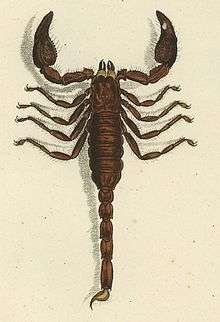Scorpionidae
The Scorpionidae (burrowing scorpions or pale-legged scorpions) make up the superfamily Scorpionoidea. The family was established by Pierre André Latreille, 1802.
| Scorpionidae | |
|---|---|
 | |
| Heterometrus indus | |
| Scientific classification | |
| Kingdom: | |
| Phylum: | |
| Class: | |
| Order: | |
| Superfamily: | |
| Family: | Scorpionidae Latreille, 1802 |
| Subfamilies | |
| |
List of genera and selected species
[2] According to The Scorpion Files[3] and Prendini & Francke:[4]
- Scorpioninae Latreille, 1802
- Heterometrus Ehrenberg, 1828
- Opistophthalmus Koch, 1837
- Pandinus Thorell, 1876
- Scorpio Linnaeus, 1758
- †Mioscorpio Kjellesvig-Waering, 1986
- †Sinoscorpius Hong, 1983
- Diplocentrinae Karsch, 1880
- Diplocentrini Karsch, 1880
- Nebini Kraepelin, 1905
- Nebo Simon, 1878
- Rugodentinae Bastawade, Sureshan & Radhakrishnan, 2005
- Rugodentus Bastawade, Sureshan & Radhakrishnan, 2005
- Urodacinae Pocock, 1893
- Urodacus Peters, 1861
- Aops Volschenk & Prendini, 2008
gollark: Android runs Linux internally, just with the horrible, horrible Android userspace!
gollark: > yes
gollark: I am hoping to switch to a pinephone next year.
gollark: Probably, but it's one of the annoying ones with non-user-replaceable batteries!
gollark: In the car situation.
References
| Wikimedia Commons has media related to Diplocentrinae. |
- Reginald Innes Pocock (1893). "Arizona Scorpions Species".
- "Arizona Scorpions Species". Retrieved 2013-10-18.
- The Scorpion Files
- Classification de Hallan Archived 2014-10-12 at the Wayback Machine
- Peters (1861). "Arizona Scorpions Species".
- Oscar F. Francke (1863). "Arizona Scorpions Species". Taxonomy of scorpions.
- Herbert L. Stahnke (1970). "Arizona Scorpions Species".
This article is issued from Wikipedia. The text is licensed under Creative Commons - Attribution - Sharealike. Additional terms may apply for the media files.